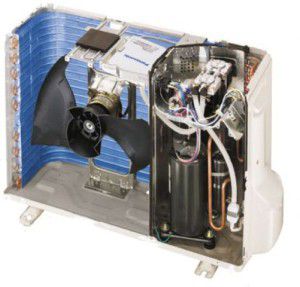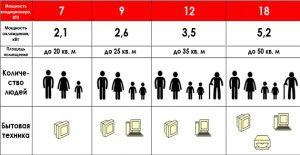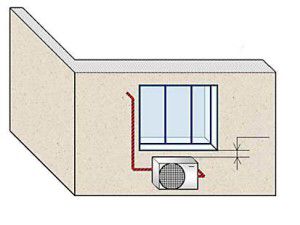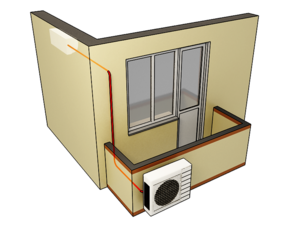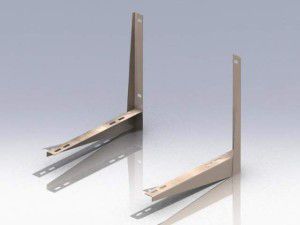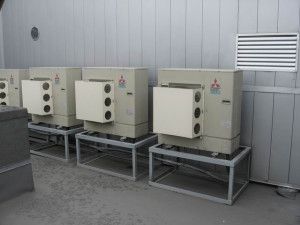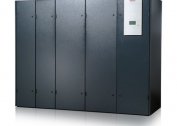Domestic and semi-industrial split systems consist of two blocks: internal and external, which is located outdoors. Such a separation is justified and even beneficial for users, since the most noisy components of the device - a compressor and a fan - are taken "overboard", and there is absolutely no need to think about where to take warm air.
Indoor unit air conditioner outdoor unit
Regardless of the construction type the split system belongs to, its outdoor module always has the same operating units:
- The compressor is responsible for compressing freon under pressure until it enters the liquid phase;
- The fan provides blowing of the heat exchanger and removal of warm air from the unit during cooling or its intake during heating;
- The condenser is responsible for cooling freon and its condensation;
- The Freon system filter protects the system circuit from dust, dirt and other small debris;
- A capillary tube or expansion valve (thermostatic expansion valve) is needed to adjust the pressure and the transition of freon into a mixture of gas and liquid.
If the air conditioner can operate in the heat pump mode, the outdoor unit is equipped with a four-way valve, which is controlled by the indoor unit. The four-way valve is responsible for reversing the blocks - the external one takes heat from the street, and the internal one takes it out to the room.
Monoblock split systems
There are air conditioners without an outdoor unit, but not mobile or window installations, namely monoblock splits, in which all components are located in one module. They consist of:
- compressor;
- electric drive;
- heat exchanger;
- a fan;
- mechanical and carbon filters;
- recuperator.
For such models of split systems, a double air duct is provided, through which there is a discharge of warm exhaust air and a fence of fresh street air. Condensate escapes through the heat transfer tube along with the hot stream. Outside, the duct openings are covered with decorative ventilation grills.
Among the air conditioners without an outdoor unit, there are models that work not only for cold, but also for cold / heat. Manufacturers produce monoblock split systems with both linear (on / off) and inverter drives. There are even multi-split systems with two connected units that can function together and separately. They have a small difference in height. Blocks are placed either above or below on the wall.
Most air conditioners that do not have an outdoor unit operate in standard modes: cooling, heating, ventilation, air drainage. The average noise level is 28-37 dB with energy efficiency from class A to A ++. Many have convenient settings like:
- additional heater;
- on / off timer;
- air distributor;
- defrost function;
- economical mode of night energy consumption.
The main part of monoblock split systems has an extended range of operating temperatures, which allows them to function in severe frosts.
The main advantages of such devices include:
- lightweight wall mounting;
- inflow of fresh air;
- lack of need to lay a drain for the non-reversible device.
But they also have significant disadvantages, which are noted not only by installers, but also by the buyers themselves:
- fixed installation, suggesting placement only on the outer wall of the room;
- very sensitive heat exchanger;
- fungus on the wall outside from constantly draining condensate;
- increased noise (when compared with conventional two-block systems);
- uneven distribution of flows when installing the unit closer to the floor;
- high price that does not meet user expectations.
Many are alarmed by the fact that the world's leading climate technology leaders do not produce monoblock split designs. Most of them are owned by Chinese companies. In Russia, the following brands can be found on store shelves:
In some cases, when the rules prohibit the installation of an outdoor air conditioning unit on the facade, a one-piece system is the only way to solve the problem of air conditioning in an apartment or office.
Dimensions and power of the outdoor unit
The selection of the outdoor unit of the air conditioner and the place for its installation depends on the size of the unit. The concept of dimensions includes closely related specific quantities that denote the physical parameters of the module, that is, height (H), width (W), depth (G), and cold power, which can be either nominal or variable.
Some condensers require very powerful blowing, which can only be provided by two fans, respectively, the dimensions of such a module will differ significantly from the dimensions of the unit cooling a small room in the apartment. When the power exceeds the established limits of the norm for the dimensions of the case, the question arises of selecting a module with large dimensions.
In the technical characteristics of the device, data such as H * W * D and cooling capacity are usually indicated. The former are measured in millimeters (mm), the latter in kilowatts (kW).
The size of the outdoor unit of the air conditioner is affected by its power, and on it - the area of the heat exchanger, compressor and fan.
Space for outdoor unit
As already mentioned, the size of the outdoor unit sometimes determines the most optimal place for its installation.
The standard installation involves mounting the device under the window just below the window sill or on the side of the window without entering the territory of the neighboring apartment. But there are not quite standard options for the location of the external module. If the permissible length of the route and the height difference allow, then installation can be carried out on the roof or attic of the house. Many install the unit on the facade of the balcony / loggia or inside them in the absence of full glazing. Living in a private house or on the first floor they sometimes mount it under a loggia, covering it from the adverse effects of atmospheric phenomena and thereby not violating the appearance of the structure.
Of particular interest is the installation of an outdoor unit in the basement of the house. Such a project can be carried out in the presence of increased routes and elevation. If the basement is heated, the air conditioner can not only cool, but also bask in the cold.
To do this, there is no need to install a winter kit on the device or buy a system with an extended range of operating temperatures, since the outdoor air conditioning unit installed in the basement will not be exposed to extremely low temperatures. The main thing is to ensure normal air circulation so that the heat exchanger does not overheat.
In summer, in such rooms it is usually cool, therefore, there is a plus here - with this arrangement, the external module will give greater efficiency, since the air is colder there than on the street.
What is the outdoor unit attached to
During installation, the external module must be fixed.For standard fastening of the block to the wall of the building, brackets consisting of two welded trims are used. They are usually made of a solid profile of different sections. They have two holes for attaching to the wall and two for installing the air conditioner itself. Such fasteners can withstand loads several times the weight of the middle block.
To install the device on the roof, floor, ground, use universal stands for the outdoor unit of the air conditioner, which are made of metal and coated with powder paint. They are attached to the surface through welded openings with frame-facade fasteners and have sliding strips that can be adjusted to any size of the device. As a rule, the stand for the outdoor unit of the air conditioner can withstand more than 250 kg, which corresponds to the weight of a very powerful industrial unit.
Rules for installing the outdoor unit
Before proceeding with fixing, it is necessary to take into account the installation rules of the outdoor unit of the air conditioner, non-observance of which entails incorrect operation of the device:
- The device must not break the silence at night - the maximum allowable noise is about 32 dB. It is necessary to organize a normal condensate drain so that it does not fall on the walls of the house, the visor of the entrance and people passing by;
- Be sure to take into account the strength of the walls. It must withstand a load of several tens of kilograms. You can not attach the air conditioner to the structures of aerated concrete, the outer cladding of the house and the insulation layer;
- Brackets with a block provide the most reliable base and fastening;
- In order to prevent overheating of the compressor, the minimum distance from the wall to the outdoor unit should not be less than 10 cm. There should be no obstacles to normal airflow;
- Air conditioning is placed taking into account the need for free air circulation. The radiator needs proper cooling;
- Provide good access to service valves so that routine inspection can be performed;
- Multiple bending of the copper pipeline should not be allowed, since the creases prevent the normal pumping of freon by the compressor;
- The maximum length of the pipeline between the modules of the split system should not exceed the length set by the manufacturer, otherwise the work efficiency drops markedly;
- Do not allow direct sunlight to hit the back of the device, so there should not be too much distance from the outer wall to the outdoor unit;
- It is advisable to provide moisture protection.
Compliance with the installers all the rules for installing the outdoor unit of the air conditioner guarantees long-term and uninterrupted operation of the chiller.
Installation steps for the outdoor unit
If the installation is carried out at the stage of repair work, then first they will ditch the wall and lay the track. When installing a split system after repair, communications are placed in boxes.
The external module itself is fixed, observing the main stages of installation work:
- Make markings for the brackets. Take into account their location relative to each other, relative to the windowsill and relative to the existing hole for the track.
- Puncher drill holes in the wall.
- Brackets are fixed with dowels with “capercaillie” or anchor bolts. They install an external unit and fix it with bolts and nuts.
- Connect freon tubes. They must first be balanced, chamfered and expanded. Only then can you connect.
- Connect the wires. Measure the desired length, strip and connect to the terminal block. The connection is carried out according to the circuit diagram indicated on the unit itself or in the user manual.
- When the internal module is already installed, a vacuum pump is connected to the external one, air is pumped out of the route and the indoor unit. Then they start the gas by opening the taps on the external unit, and tighten all the protective covers.
- Put the protective cover on the device.
If the installation is carried out by unskilled people, it may be necessary to repair the outdoor or indoor unit, which is not always cheap.
Repair and preventative maintenance
In what other cases may it be necessary to call the master and carry out repair work to troubleshoot the outdoor unit of the air conditioner?
As a rule, breakdowns of a street unit can be associated with the failure of the mechanical part of the device or electrics and electronic systems. The first group includes malfunctions of the elements of the refrigeration circuit, and the second - malfunctions in the control board or problems in the electrical circuit.
Mechanical breakdowns
If the breakdown exists precisely in the mechanical part, then this can be expressed in the form:
- freezing of the outdoor air conditioning unit;
- the appearance of uncharacteristic noise and vibration;
- reducing the efficiency of blowing the heat exchanger;
- the appearance of oil smudges on the ports.
Most of these problems are associated with the leak of freon or its initial lack. The presence of those is easily determined by the master using a manometer.
There are other reasons why the outdoor unit of the air conditioner freezes, not only in winter in heating mode, but also in summer almost immediately after installation.
The system may have excess refrigerant, excess air or excess moisture. It is possible that the capillary tubes are clogged or the device just needs preventative cleaning, which includes washing the panels of both blocks, cleaning or replacing the filters, and also removing excess dirt from the fan and heat exchanger. Often there is such a problem as the incorrect length of the copper pipeline, which causes either a shortage or an excess of freon.
If none of these reasons is detected, refueling or complete refueling is carried out, and the outdoor unit of the air conditioner continues to freeze, then you should look for the cause of the compressor malfunction.
Failures in electrical and electronics
No less serious problem can be the failure of the control board. As a rule, this is indicated by error codes and LED lamps on the housing of the indoor unit, which give the corresponding brake lights. If the board burns out, the outdoor unit of the air conditioner may smoke, although smoke can sometimes indicate burnout of the compressor motor or blower fan.
At the slightest suspicion of a malfunction in the electrician, you must immediately turn off the machine in the electrical panel, which is responsible for the air conditioner.
If the outdoor unit of the air conditioner smokes in the heating mode in winter, this may indicate not a fire, but a defrosting of the heat exchanger (condenser). In this case, the smoke is just steam.
Regardless of the complexity of the breakdown, you must immediately turn off the power and call the wizard from the after-sales service, who will inspect the system and repair the outdoor unit, if necessary.
